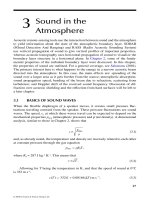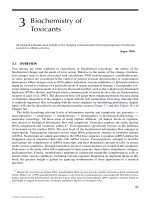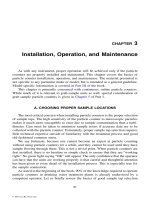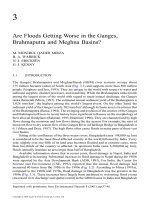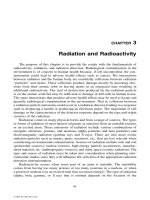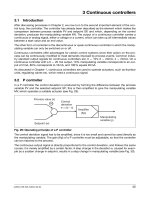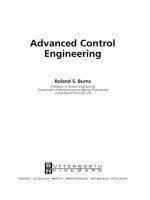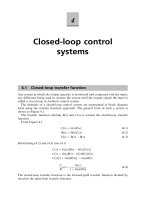Advanced Control Engineering - Chapter 3 ppt
Bạn đang xem bản rút gọn của tài liệu. Xem và tải ngay bản đầy đủ của tài liệu tại đây (237.82 KB, 28 trang )
//SYS21/D:/B&H3B2/ACE/REVISES(08-08-01)/ACEC03.3D ± 35 ± [35±62/28] 9.8.2001 2:26PM
3
Time domain analysis
3.1 Introduction
The manner in which a dynamic system responds to an input, expressed as a function
of time, is called the time response. The theoretical evaluation of this response is said
to be undertaken in the time domain, and is referred to as time domain analysis. It is
possible to compute the time response of a system if the following is known:
.
the nature of the input(s), expressed as a function of time
.
the mathematical model of the system.
The time response of any system has two components:
(a) Transient response: This component of the response will (for a stable system)
decay, usually exponentially, to zero as time increases. It is a function only of the
system dynamics, and is independent of the input quantity.
(b) Steady-state response: This is the response of the system after the transient
component has decayed and is a function of both the system dynamics and the
input quantity.
Transient Period
( )
xt
i
Steady-State Error
Transient
Error
Steady-State Period
t
( )
xt
o
( )
xt
o
Fig. 3.1 Transient and steady-state periods of time response.
//SYS21/D:/B&H3B2/ACE/REVISES(08-08-01)/ACEC03.3D ± 36 ± [35±62/28] 9.8.2001 2:26PM
The total response of the system is always the sum of the transient and steady-state
components. Figure 3.1 shows the transient and steady-state periods of time
response. Differences between the input function x
i
(t) (in this case a ramp function)
and system response x
o
(t) are called transient errors during the transient period, and
steady-state errors during the steady-state period. One of the major objectives of
control system design is to minimize these errors.
3.2 Laplace transforms
In order to compute the time response of a dynamic system, it is necessary to solve
the differential equations (system mathematical model) for given inputs. There are
a number of analytical and numerical techniques available to do this, but the one
favoured by control engineers is the use of the Laplace transform.
This technique transforms the problem from the time (or t) domain to the Laplace
(or s) domain. The advantage in doing this is that complex time domain differential
equations become relatively simple s domain algebraic equations. When a suitable
solution is arrived at, it is inverse transformed back to the time domain. The process
is shown in Figure 3.2.
The Laplace transform of a function of time f(t) is given by the integral
l[ f (t)]
I
0
f (t)e
Àst
dt F(s)(3:1)
where s is a complex variable Æ j! and is called the Laplace operator.
Laplace
Transform
Inverse
Laplace
Transform
L [ ( )] = ( )
ft Fs
L
–1
[ ( )] = ( )
Fs ft
sFs
Domain ( )
Algebraic
equations
Time Domain ( )
ft
Differential
equations
Fig. 3.2 The Laplace transform process.
36 Advanced Control Engineering
//SYS21/D:/B&H3B2/ACE/REVISES(08-08-01)/ACEC03.3D ± 37 ± [35±62/28] 9.8.2001 2:26PM
3.2.1 Laplace transforms of common functions
Example 3.1
f (t) 1 (called a unit step function).
Solution
From equation (3.1)
l[ f (t)] F(s)
I
0
1e
Àst
dt
À
1
s
(e
Àst
)
!
I
0
À
1
s
(0 À1)
!
1
s
(3:2)
Example 3.2
f (t) e
Àat
l[ f (t)] F(s)
I
0
e
Àat
e
Àst
dt
I
0
e
À(sa)t
dt
À
1
s a
(e
À(sa)t
)
!
I
0
À
1
s a
(0 À1)
!
1
s a
(3:3)
Table 3.1 gives further Laplace transforms of common functions (called Laplace
transform pairs).
3.2.2 Properties of the Laplace transform
(a) Derivatives: The Laplace transform of a time derivative is
d
n
dt
n
f (t) s
n
F(s) Àf (0)s
nÀ1
À f
H
(0)s
nÀ2
ÀÁÁÁ (3:4)
where f(0), f
H
(0) are the initial conditions, or the values of f (t), d/dtf(t)etc.att 0
(b) Linearity
l[ f
1
(t) Æf
2
(t)] F
1
(s) ÆF
2
(s)(3:5)
Time domain analysis 37
//SYS21/D:/B&H3B2/ACE/REVISES(08-08-01)/ACEC03.3D ± 38 ± [35±62/28] 9.8.2001 2:26PM
Table 3.1 Common Laplace transform pairs
Time function f (t) Laplace transform l[ f (t)] F (s)
1 unit impulse (t)1
2 unit step 1 1/s
3 unit ramp t 1/s
2
4 t
n
n3
s
n1
5e
Àat
1
(s a)
61À e
Àat
a
s(s a)
7 sin !t
!
s
2
!
2
8 cos !t
s
s
2
!
2
9e
Àat
sin !t
!
(s a)
2
!
2
10 e
Àat
(cos !t À
a
!
sin !t)
s
(s a)
2
!
2
(c) Constant multiplication
l[af (t)] aF(s)(3:6)
(d) Real shift theorem
l[ f (t ÀT )] e
ÀTs
F(s) for T ! 0(3:7)
(e) Convolution integral
t
0
f
1
()f
2
(t À)d F
1
(s)F
2
(s)(3:8)
(f) Initial value theorem
f (0) lim
t30
[ f (t)] lim
s3I
[sF(s)] (3:9)
(g) Final value theorem
f (I) lim
t3I
[ f (t)] lim
s30
[sF(s)] (3:10)
3.2.3 Inverse transformation
The inverse transform of a function of s is given by the integral
f (t) l
À1
[F(s)]
1
2j
j!
Àj!
F(s)e
st
ds (3:11)
38 Advanced Control Engineering
//SYS21/D:/B&H3B2/ACE/REVISES(08-08-01)/ACEC03.3D ± 39 ± [35±62/28] 9.8.2001 2:26PM
In practice, inverse transformation is most easily achieved by using partial fractions
to break down solutions into standard components, and then use tables of Laplace
transform pairs, as given in Table 3.1.
3.2.4 Common partial fraction expansions
(i) Factored roots
K
s(s a)
A
s
B
(s a)
(3:12)
(ii) Repeated roots
K
s
2
(s a)
A
s
B
s
2
C
(s a)
(3:13)
(iii) Second-order real roots (b
2
> 4ac)
K
s(as
2
bs c)
K
s(s d)(s e)
A
s
B
(s d)
C
(s e)
(iv) Second-order complex roots (b
2
< 4ac)
K
s(as
2
bs c)
A
s
Bs C
as
2
bs c
Completing the square gives
A
s
Bs C
(s )
2
!
2
(3:14)
Note: In (iii) and (iv) the coefficient a is usually factored to a unity value.
3.3 Transfer functions
A transfer function is the Laplace transform of a differential equation with zero
initial conditions. It is a very easy way to transform from the time to the s domain,
and a powerful tool for the control engineer.
Example 3.3
Find the Laplace transform of the following differential equation given:
(a) initial conditions x
o
4, dx
o
/dt 3
(b) zero initial conditions
d
2
x
o
dt
2
3
dx
o
dt
2x
o
5
Time domain analysis 39
//SYS21/D:/B&H3B2/ACE/REVISES(08-08-01)/ACEC03.3D ± 40 ± [35±62/28] 9.8.2001 2:26PM
Solution
(a) Including initial conditions: Take Laplace transforms (equation (3.4), Table 3.1).
(s
2
X
o
(s) À4s À3) 3(sX
o
(s) À4) 2X
o
(s)
5
s
s
2
X
o
(s) 3sX
o
(s) 2X
o
(s)
5
s
4s 3 12
(s
2
3s 2)X
o
(s)
5 4s
2
15s
s
X
o
(s)
4s
2
15s 5
s(s
2
3s 2)
(3:15)
(b) Zero initial conditions
At t 0, x
o
0, dx
o
/dt 0.
Take Laplace transforms
s
2
X
o
(s) 3sX
o
(s) 2X
o
(s)
5
s
X
o
(s)
5
s(s
2
3s 2)
(3:16)
Example 3.3(b) is easily solved using transfer functions. Figure 3.3 shows the general
approach. In Figure 3.3
.
X
i
(s) is the Laplace transform of the input function.
.
X
o
(s) is the Laplace transform of the output function, or system response.
.
G(s) is the transfer function, i.e. the Laplace transform of the differential equation
for zero initial conditions.
The solution is therefore given by
X
o
(s) G(s)X
i
(s)(3:17)
Thus, for a general second-order transfer function
a
d
2
x
o
dt
2
b
dx
o
dt
cx
o
Kx
i
(t)
(as
2
bs c)X
o
(s) KX
i
(s)
Hence
X
o
(s)
K
as
2
bs c
&'
X
i
(s)(3:18)
()
Xs
i
()
Gs
()
Xs
o
Fig. 3.3 The transfer function approach.
40 Advanced Control Engineering
//SYS21/D:/B&H3B2/ACE/REVISES(08-08-01)/ACEC03.3D ± 41 ± [35±62/28] 9.8.2001 2:26PM
Comparing equations (3.17) and (3.18), the transfer function G(s)is
G(s)
K
as
2
bs c
(3:19)
which, using the form shown in Figure 3.3, can be expressed as shown in Figure 3.4.
Returning to Example 3.3(b), the solution, using the transfer function approach is
shown in Figure 3.5. From Figure 3.5
X
o
(s)
5
s(s
2
3s 2)
(3:20)
which is the same as equation (3.16).
3.4 Common time domain input functions
3.4.1 The impulse function
An impulse is a pulse with a width Át 3 0 as shown in Figure 3.6. The strength of an
impulse is its area A, where
A height h ÂÁt: (3:21)
The Laplace transform of an impulse function is equal to the area of the function.
The impulse function whose area is unity is called a unit impulse (t).
3.4.2 The step function
A step function is described as x
i
(t) B; X
i
(s) B/s for t > 0 (Figure 3.7). For a unit
step function x
i
(t) 1; X
i
(s) 1/s. This is sometimes referred to as a `constant
position' input.
Xs
i
()
K
Xs
o
()
as bs c
2
++
Fig. 3.4 General second-order transfer function.
Xs s
i
()=5/
1
ss
2
+3 +2
X
o
()
s
Fig. 3.5 Example 3.3(b) expressed as a transfer function.
Time domain analysis 41
//SYS21/D:/B&H3B2/ACE/REVISES(08-08-01)/ACEC03.3D ± 42 ± [35±62/28] 9.8.2001 2:26PM
3.4.3 The ramp function
A ramp function is described as x
i
(t) Qt; X
i
(s) Q/s
2
for t > 0 (Figure 3.8). For a
unit ramp function x
i
(t) t; X
i
(s) 1/s
2
. This is sometimes referred to as a `constant
velocity' input.
3.4.4 The parabolic function
A parabolic function is described as x
i
(t) Kt
2
; X
i
(s) 2K/s
3
for t > 0 (Figure 3.9).
For a unit parabolic function x
i
(t) t
2
; X
i
(s) 2/s
3
. This is sometimes referred to as
a `constant acceleration' input.
Impulse
()
xt
i
Pulse
h
t
∆
t
Fig. 3.6 The impulse function.
B
t
xt
i
()
Fig. 3.7 The step function.
42 Advanced Control Engineering
//SYS21/D:/B&H3B2/ACE/REVISES(08-08-01)/ACEC03.3D ± 43 ± [35±62/28] 9.8.2001 2:26PM
3.5 Time domain response of first-order systems
3.5.1 Standard form
Consider a first-order differential equation
a
dx
o
dt
bx
o
cx
i
(t)(3:22)
Take Laplace transforms, zero initial conditions
asX
o
(s) bX
o
(s) cX
i
(s)
(as b)X
o
(s) cX
i
(s)
xt
i
()
Q
t
Fig. 3.8 The ramp function.
x
i
( )
t
t
Fig. 3.9 The parabolic function.
Time domain analysis 43
//SYS21/D:/B&H3B2/ACE/REVISES(08-08-01)/ACEC03.3D ± 44 ± [35±62/28] 9.8.2001 2:26PM
The transfer function is
G(s)
X
o
X
i
(s)
c
as b
To obtain the standard form, divide by b
G(s)
c
b
1
a
b
s
which is written
G(s)
K
1 Ts
(3:23)
Equation (3.23) is the standard form of transfer function for a first-order system,
where K steady-state gain constant and T time constant (seconds).
3.5.2 Impulse response of first-order systems
Example 3.4 (See also Appendix 1, examp34.m)
Find an expression for the response of a first-order system to an impulse function of
area A.
Solution
From Figure 3.10
X
o
(s)
AK
1 Ts
AK=T
s 1=T
(3:24)
or
X
o
(s)
AK
T
1
(s a)
(3:25)
Equation (3.25) is in the form given in Laplace transform pair 5, Table 3.1, so the
inverse transform becomes
x
o
(t)
AK
T
e
Àat
AK
T
e
Àt=T
(3:26)
The impulse response function, equation (3.26) is shown in Figure 3.11.
Xs A
i
()=
()
Xs
o
K
1+
Ts
Fig. 3.10 Impulse response of a first-order system.
44 Advanced Control Engineering
//SYS21/D:/B&H3B2/ACE/REVISES(08-08-01)/ACEC03.3D ± 45 ± [35±62/28] 9.8.2001 2:26PM
3.5.3 Step response of first-order systems
Example 3.5 (See also Appendix 1, examp35.m)
Find an expression for the response of a first-order system to a step function of
height B.
Solution
From Figure 3.12
X
o
(s)
BK
s(1 Ts)
BK
1=T
ss 1=T
(3:27)
Equation (3.27) is in the form given in Laplace transform pair 6 Table 3.1, so the
inverse transform becomes
x
o
(t) BK 1 À e
Àt=T
(3:28)
If B 1 (unit step) and K 1 (unity gain) then
x
o
(t) 1 Àe
Àt=T
(3:29)
When time t is expressed as a ratio of time constant T, then Table 3.2 and Figure 3.13
can be constructed.
Table 3.2 Unit step response of a first-order system
t/T 0 0.25 0.5 0.75 1 1.5 2 2.5 3 4
x
o
(t) 0 0.221 0.393 0.527 0.632 0.770 0.865 0.920 0.950 0.980
x
o
()
t
AK
T
t
Fig. 3.11 Response ofa first-order system to an impulse function of area A.
Time domain analysis 45
//SYS21/D:/B&H3B2/ACE/REVISES(08-08-01)/ACEC03.3D ± 46 ± [35±62/28] 9.8.2001 2:26PM
3.5.4 Experimental determination of system time constant
using step response
Method one: The system time constant is the time the system takes to reach 63.2% of
its final value (see Table 3.2).
Method two: The system time constant is the intersection of the slope at t 0with
the final value line (see Figure 3.13) since
x
o
(t) 1 À e
Àt=T
dx
o
dt
0 ÀÀ
1
T
e
Àt=T
1
T
e
Àt=T
(3:30)
dx
o
dt
j
t0
1
T
at t 0(3:31)
This also applies to any other tangent, see Figure 3.13.
X
i
()=/
sB s
X
o
()
s
K
1+
Ts
Fig. 3.12 Step response of a first-order system.
1.2
1
0.8
0.6
0.4
0.2
0
0
0.5
1
1.5
2
2.5
3
3.5
4
4.5
x
t
o
( )
Number of Time Constants
T
T
Fig. 3.13 Unit step response of a first-order system.
46 Advanced Control Engineering
//SYS21/D:/B&H3B2/ACE/REVISES(08-08-01)/ACEC03.3D ± 47 ± [35±62/28] 9.8.2001 2:26PM
3.5.5 Ramp response of first-order systems
Example 3.6
Find an expression for the response of a first-order system to a ramp function of
slope Q.
Solution
From Figure 3.14
X
o
(s)
QK
s
2
(1 Ts)
QK=T
s
2
(s 1=T )
A
s
B
s
2
C
(s 1=T )
(3:32)
(See partial fraction expansion equation (3.13)). Multiplying both sides by
s
2
(s 1/T), we get
QK
T
As s
1
T
Bs
1
T
Cs
2
i:e:
QK
T
As
2
A
T
s Bs
B
T
Cs
2
(3:33)
Equating coefficients on both sides of equation (3.33)
(s
2
) X 0 A C(3:34)
(s
1
) X 0
A
T
B(3:35)
(s
0
) X
QK
T
B
T
(3:36)
From (3.34)
C ÀA
From (3.36)
B QK
Substituting into (3.35)
A ÀQKT
Hence from (3.34)
C QKT
K
1+
Ts
Xs Qs
i
()= /
2
Xs
o
()
Fig. 3.14 Ramp response of a first-order system (see also Figure A1.1).
Time domain analysis 47
//SYS21/D:/B&H3B2/ACE/REVISES(08-08-01)/ACEC03.3D ± 48 ± [35±62/28] 9.8.2001 2:26PM
Inserting values of A, B and C into (3.32)
X
o
(s) À
QKT
s
QK
s
2
QKT
(s 1=T)
(3:37)
Inverse transform, and factor out KQ
x
o
(t) KQ t À T Te
Àt=T
(3:38)
If Q 1 (unit ramp) and K 1 (unity gain) then
x
o
(t) t ÀT Te
Àt=T
(3:39)
The first term in equation (3.39) represents the input quantity, the second is the
steady-state error and the third is the transient component. When time t is expressed
as a ratio of time constant T, then Table 3.3 and Figure 3.15 can be constructed. In
Figure 3.15 the distance along the time axis between the input and output, in the
steady-state, is the time constant.
Table 3.3 Unit ramp response of a first-order system
t/T 01234567
x
i
(t)/T 01234567
x
o
(t)/T 0 0.368 1.135 2.05 3.018 4.007 5 6
8
7
6
5
4
3
2
1
0
0
1
2
3
4
5
x
t
T
o
( ) × (1/ )
Number of Time Constants
6
7
Fig. 3.15 Unit ramp response of a first-order system.
48 Advanced Control Engineering
//SYS21/D:/B&H3B2/ACE/REVISES(08-08-01)/ACEC03.3D ± 49 ± [35±62/28] 9.8.2001 2:26PM
3.6 Time domain response of second-order systems
3.6.1 Standard form
Consider a second-order differential equation
a
d
2
x
o
dt
2
b
dx
o
dt
cx
o
ex
i
(t)(3:40)
Take Laplace transforms, zero initial conditions
as
2
X
o
(s) bsX
o
(s) cX
o
(s) eX
i
(s)
(as
2
bs c)X
o
(s) eX
i
(s)(3:41)
The transfer function is
G(s)
X
o
X
i
(s)
e
as
2
bs c
To obtain the standard form, divide by c
G(s)
e
c
a
c
s
2
b
c
s 1
which is written as
G(s)
K
1
!
2
n
s
2
2
!
n
s 1
(3:42)
This can also be normalized to make the s
2
coefficient unity, i.e.
G(s)
K!
2
n
s
2
2!
n
s !
2
n
(3:43)
Equations (3.42) and (3.43) are the standard forms of transfer functions for a second-
order system, where K steady-state gain constant, !
n
undamped natural
frequency (rad/s) and damping ratio. The meaning of the parameters !
n
and
are explained in sections 3.6.4 and 3.6.3.
3.6.2 Roots of the characteristic equation and their
relationship to damping in second-order systems
As discussed in Section 3.1, the transient response of a system is independent of the
input. Thus for transient response analysis, the system input can be considered to be
zero, and equation (3.41) can be written as
(as
2
bs c)X
o
(s) 0
If X
o
(s) T 0, then
as
2
bs c 0(3:44)
Time domain analysis 49
//SYS21/D:/B&H3B2/ACE/REVISES(08-08-01)/ACEC03.3D ± 50 ± [35±62/28] 9.8.2001 2:26PM
Table 3.4 Transient behaviour of a second-order system
Discriminant Roots Transient response type
b
2
> 4ac s
1
and s
2
real
and unequal
(Àve)
Overdamped
Transient
Response
b
2
4ac s
1
and s
2
real
and equal
(Àve)
Critically
Damped Transient
Response
b
2
< 4ac s
1
and s
2
complex
conjugate of the
form: s
1
, s
2
À Æ j!
Underdamped
Transient
Response
This polynomial in s is called the Characteristic Equation and its roots will determine
the system transient response. Their values are
s
1
, s
2
Àb Æ
b
2
À 4ac
p
2a
(3:45)
The term (b
2
À 4ac), called the discriminant, may be positive, zero or negative which
will make the roots real and unequal, real and equal or complex. This gives rise to the
three different types of transient response described in Table 3.4.
The transient response of a second-order system is given by the general solution
x
o
(t) Ae
s
1
t
Be
s
2
t
(3:46)
This gives a step response function of the form shown in Figure 3.16.
xt
o
()
Underdamping ( and complex)
ss
12
Critical damping
( and real and equal)
ss
12
Overdamping
( and real and unequal)
ss
12
t
Fig. 3.16 Effect that roots of the characteristic equation have on the damping ofa second-order system.
50 Advanced Control Engineering
//SYS21/D:/B&H3B2/ACE/REVISES(08-08-01)/ACEC03.3D ± 51 ± [35±62/28] 9.8.2001 2:26PM
3.6.3 Critical damping and damping ratio
Critical damping
When the damping coefficient C of a second-order system has its critical value C
c
, the
system, when disturbed, will reach its steady-state value in the minimum time without
overshoot. As indicated in Table 3.4, this is when the roots of the Characteristic
Equation have equal negative real roots.
Damping ratio z
The ratio of the damping coefficient C in a second-order system compared with the
value of the damping coefficient C
c
required for critical damping is called the
Damping Ratio (Zeta). Hence
C
C
c
(3:47)
Thus
0 No damping
<1 Underdamping
1 Critical damping
>1 Overdamping
Example 3.7
Find the value of the critical damping coefficient C
c
in terms of K and m for the
spring±mass±damper system shown in Figure 3.17.
C
K
Ft
( )
xt
o
( )
(a)
Lumped Parameter Diagram
m
Ft
( )
(b)
Free-Body Diagram
m
C
x
o
Kx
o
xt
o
( )
x
o
( )
t
ve+
1
o
( )
t
Fig. 3.17 Spring^mass ^damper system.
Time domain analysis 51
//SYS21/D:/B&H3B2/ACE/REVISES(08-08-01)/ACEC03.3D ± 52 ± [35±62/28] 9.8.2001 2:26PM
Solution
From Newton's second law
Fx m
x
o
From the free-body diagram
F(t) ÀKx
o
(t) ÀC
x
o
(t) m
x
o
(t)(3:48)
Taking Laplace transforms, zero initial conditions
F(s) ÀKX
o
(s) ÀCsX
o
(s) ms
2
X
o
(s)
or
(ms
2
Cs K)X
o
(s) F(s)(3:49)
Characteristic Equation is
ms
2
Cs K 0
i:e: s
2
C
m
K
m
0
and the roots are
s
1
, s
2
1
2
C
m
Æ
C
m
2
À4
K
m
s
V
`
X
W
a
Y
(3:50)
For critical damping, the discriminant is zero, hence the roots become
s
1
s
2
À
C
c
2m
Also, for critical damping
C
2
c
m
2
4K
m
C
2
c
4Km
2
m
giving
C
c
2
Km
p
(3:51)
3.6.4 Generalized second-order system response to a unit step
input
Consider a second-order system whose steady-state gain is K, undamped natural
frequency is !
n
and whose damping ratio is , where <1. For a unit step input, the
block diagram is as shown in Figure 3.18. From Figure 3.18
X
o
(s)
K!
2
n
s(s
2
2!
n
s !
2
n
)
(3:52)
52 Advanced Control Engineering
//SYS21/D:/B&H3B2/ACE/REVISES(08-08-01)/ACEC03.3D ± 53 ± [35±62/28] 9.8.2001 2:26PM
Expanding equation (3.52) using partial fractions
X
o
(s)
A
s
Bs C
s
2
2!
n
s !
2
n
(3:53)
Equating (3.52) and (3.53) and multiply by ss
2
2!
n
s !
2
n
ÀÁ
K!
2
n
As
2
2!
n
s !
2
n
ÀÁ
Bs
2
Cs
Equating coefficients
(s
2
) X 0 A B
(s
1
) X 0 2!
n
A C
(s
0
) X K!
2
n
!
2
n
A
giving
A K, B ÀK and C À2!
n
K
Substituting back into equation (3.53)
X
o
(s) K
1
s
À
s 2!
n
s
2
2!
n
s !
2
n
&' !
Completing the square
X
o
(s) K
1
s
À
s 2!
n
(s !
n
)
2
!
2
n
À
2
!
2
n
@A45
K
1
s
À
s 2!
n
(s !
n
)
2
!
n
1 À
2
p
2
V
b
`
b
X
W
b
a
b
Y
P
T
R
Q
U
S
(3:54)
The terms in the brackets { } can be written in the standard forms 10 and 9 in
Table 3.1.
Term (1)
Às
(s !
n
)
2
!
n
1 À
2
p
2
Term (2) À
2!
n
!
n
1 À
2
p
@A
!
n
1 À
2
p
s
2
!
n
2
!
n
1 À
2
p
2
V
b
`
b
X
W
b
a
b
Y
Xs s
i
( )=1/
X
o
()
s
K
ω
n
2
sss
2
2
+2 +ζω ω
nn
Fig. 3.18 Step response of a generalized second-order system for <1.
Time domain analysis 53
//SYS21/D:/B&H3B2/ACE/REVISES(08-08-01)/ACEC03.3D ± 54 ± [35±62/28] 9.8.2001 2:26PM
Inverse transform
x
o
(t) K 1 À e
À!
n
t
cos !
n
1 À
2
p
t À
!
n
!
n
1 À
2
p
sin !
n
1 À
2
p
t
23@A4
À
2
1 À
2
p
@A
e
À!
n
t
sin !
n
1 À
2
p
t
no
5
(3:55)
Equation (3.55) can be simplified to give
x
o
(t) K 1 À e
À!
n
t
cos !
n
1 À
2
p
t
1 À
2
p
23
sin !
n
1 À
2
p
t
A@54
(3:56)
When 0
x
o
(t) K[1 Àe
0
fcos !
n
t 0g]
K[1 Àcos !
n
t](3:57)
From equation (3.57) it can be seen that when there is no damping, a step input will
cause the system to oscillate continuously at !
n
(rad/s).
Damped natural frequency w
d
From equation (3.56), when 0 <>1, the frequency of transient oscillation is
given by
!
d
!
n
1 À
2
p
(3:58)
where !
d
is called the damped natural frequency. Hence equation (3.56) can be
written as
x
o
(t) K 1 À e
À!
n
t
cos !
d
t
1 À
2
p
23
sin !
d
t
@A45
(3:59)
K 1 À
e
À!
n
t
1 À
2
p
sin (!
d
t )
45
(3:60)
where
tan
1 À
2
p
(3:61)
When 1, the unit step response is
x
o
(t) K[1 Àe
À!
n
t
(1 !
n
t)] (3:62)
and when >1, the unit step response from equation (3.46) is given by
x
o
(t) K 1 À
1
2
2
2
À 1
p
23
e
À
2
À1
p
ÀÁ
!
n
t
@4
1
2
À
2
2
À 1
p
23
e
ÀÀ
2
À1
p
ÀÁ
!
n
t
A5
(3:63)
54 Advanced Control Engineering
//SYS21/D:/B&H3B2/ACE/REVISES(08-08-01)/ACEC03.3D ± 55 ± [35±62/28] 9.8.2001 2:27PM
The generalized second-order system response to a unit step input is shown in Figure
3.19 for the condition K 1 (see also Appendix 1, sec_ord.m).
3.7 Step response analysis and performance
specification
3.7.1 Step response analysis
It is possible to identify the mathematical model of an underdamped second-order
system from its step response function.
Consider a unity-gain (K 1) second-order underdamped system responding to
an input of the form
x
i
(t) B (3:64)
The resulting output x
o
(t) would be as shown in Figure 3.20. There are two methods
for calculating the damping ratio.
Method (a): Percentage Overshoot of first peak
%Overshoot
a
1
B
 100 (3:65)
Now
a
1
Be
À!
n
(=2)
1.6
1.4
1.2
1
0.8
0.6
0.4
0.2
0
0
0.5
1
1.5
2
2.5
3
3.5
4
4.5
5
5.5
6
6.5
7
7.5
8
8.5
9
9.5
10
10.5
11
11.5
12
12.5
13
13.5
14
14.5
ζ = 0.2
ζ = 0.4
ζ = 0.6
ζ = 0.8
ζ = 1.0
ζ = 2.0
ω
n
t
(rad)
xt
o
( )
Fig. 3.19 Unit step response of a second-order system.
Time domain analysis 55
//SYS21/D:/B&H3B2/ACE/REVISES(08-08-01)/ACEC03.3D ± 56 ± [35±62/28] 9.8.2001 2:27PM
Thus,
%Overshoot
Be
À!
n
(=2)
B
 100 (3:66)
Since the frequency of transient oscillation is !
d
, then,
2
!
d
2
!
n
1 À
2
p
(3:67)
Substituting (3.67) into (3.66)
%Overshoot e
À2!
n
=2!
n
1À
2
p
 100
%Overshoot e
À=
1À
2
p
(3:68)
Method (b): Logarithmic decrement. Consider the ratio of successive peaks a
1
and a
2
a
1
Be
À!
n
(=2)
(3:69)
a
2
Be
À!
n
(3=2)
(3:70)
Hence
a
1
a
2
e
À!
n
(=2)
e
À!
n
(3=2)
e
fÀ!
n
(=2)!
n
(3=2)g
e
!
n
e
2=
1À
2
p
(3:71)
xt
o
()
(with reference to final value)
B
a
1
a
2
B
τ/2
τ
t
B
e
–
ζω
n
t
Fig. 3.20 Step response analysis.
56 Advanced Control Engineering
//SYS21/D:/B&H3B2/ACE/REVISES(08-08-01)/ACEC03.3D ± 57 ± [35±62/28] 9.8.2001 2:27PM
Equation (3.71) can only be used if the damping is light and there is more than one
overshoot. Equation (3.67) can now be employed to calculate the undamped natural
frequency
!
n
2
1 À
2
p
(3:72)
3.7.2 Step response performance specification
The three parameters shown in Figure 3.21 are used to specify performance in the
time domain.
(a) Rise time t
r
: The shortest time to achieve the final or steady-state value, for the
first time. This can be 100% rise time as shown, or the time taken for example
from 10% to 90% of the final value, thus allowing for non-overshoot response.
(b) Overshoot: The relationship between the percentage overshoot and damping
ratio is given in equation (3.68). For a control system an overshoot of between
0 and 10% (1 <>0:6) is generally acceptable.
(c) Settling time t
s
: This is the time for the system output to settle down to within a
tolerance band of the final value, normally between Æ2 or 5%.
Using 2% value, from Figure 3.21
0:02B Be
À!
n
t
s
Invert
50 e
!
n
t
s
B
e
–
ζω
n
t
(with reference to final value)
Overshoot
xt
o
( )
B
Rise
Time
t
r
Settling Time
t
s
2 or 5% of
B
–
+
t
Fig. 3.21 Step response performance specification.
Time domain analysis 57
//SYS21/D:/B&H3B2/ACE/REVISES(08-08-01)/ACEC03.3D ± 58 ± [35±62/28] 9.8.2001 2:27PM
Take natural logs
ln 50 !
n
t
s
giving
t
s
1
!
n
ln 50 (3:73)
The term (1/!
n
) is sometimes called the equivalent time constant T
c
for a second-
order system. Note that ln 50 (2% tolerance) is 3.9, and ln 20 (5% tolerance) is 3.0.
Thus the transient period for both first and second-order systems is three times the
time constant to within a 5% tolerance band, or four times the time constant to
within a 2% tolerance band, a useful rule-of-thumb.
3.8 Response of higher-order systems
Transfer function techniques can be used to calculate the time response of higher-
order systems.
Example 3.8 (See also Appendix 1, examp38.m)
Figure 3.22 shows, in block diagram form, the transfer functions for a resistance
thermometer and a valve connected together. The input x
i
(t) is temperature and the
output x
o
(t) is valve position. Find an expression for the unit step response function
when there are zero initial conditions.
Solution
From Figure 3.22
X
o
(s)
25
s(1 2s)(s
2
s 25)
(3:74)
12:5
s(s 0:5)(s
2
s 25)
(3:75)
A
s
B
(s 0:5)
Cs D
(s 0:5)
2
(4:97)
2
(3:76)
Resistance Thermometer
Valve
Xs s
i
( )=1/
Xs
o
()
1
1 + 2
s
25
ss
2
+ + 25
Fig. 3.22 Block diagram representation of a resistance thermometer and valve.
58 Advanced Control Engineering
//SYS21/D:/B&H3B2/ACE/REVISES(08-08-01)/ACEC03.3D ± 59 ± [35±62/28] 9.8.2001 2:27PM
Note that the second-order term in equation (3.76) has had the `square' completed
since its roots are complex (b
2
< 4ac). Equate equations (3.75) and (3.76) and multi-
ply both sides by s(s 0:5)(s
2
s 25).
12:5 (s
3
1:5s
2
25:5s 12:5)A (s
3
s
2
25s)B
(s
3
0:5s
2
)C (s
2
0:5s)D
(3:77)
Equating coefficients
(s
3
) X 0 A B C
(s
2
) X 0 1:5A B 0:5C D
(s
1
) X 0 25:5A 25B 0:5D
(s
0
) X 12:5 12:5A
Solving the four simultaneous equations
A 1, B À1:01, C 0:01, D À0:5
Substituting back into equation (3.76) gives
X
o
(s)
1
s
À
1:01
(s 0:5)
0:01s À0:5
(s 0:5)
2
(4:97)
2
(3:78)
Inverse transform
x
o
(t) 1 À1:01e
À0:5t
À 0:01e
À0:5t
(10:16 sin 4:97t Àcos 4:97t)(3:79)
Equation (3.79) shows that the third-order transient response contains both first-
order and second-order elements whose time constants and equivalent time constants
are 2 seconds, i.e. a transient period of about 8 seconds. The second-order element
has a predominate negative sine term, and a damped natural frequency of 4.97 rad/s.
The time response is shown in Figure 3.23.
1.2
1
0.8
0.6
0.4
0.2
0
0
12
3
4
5
6
78
9
xt
0
( )
Time (s)
Fig. 3.23 Time response of third-order system.
Time domain analysis 59
